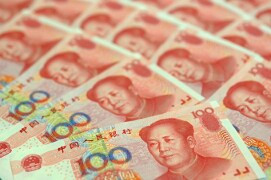
The Chinese yuan is posting modest gains against its US counterpart on Tuesday after President Xi Jinping pledged modest economic reforms. But the currencyâs boost was capped by investorsâ doubt that a trade agreement between the worldâs two largest economies is imminent.
This week, Xi delivered a 30-minute speech at the China International Import Expo, where he continued to say that Beijing was opening up its economy rather than maintaining the status quo. The Shanghai event featured more than 3,000 foreign companies, including many iconic US brands, like Google, Ford, and Boeing.
Despite unveiling roughly $150 billion in new imports, high-level US officials did not attend the event.
Last week, President Donald Trump tweeted that he enjoyed a âvery good conversationâ with his Chinese counterpart, making some investors hopeful that a trade agreement was imminent. However, these hopes were dashed when chief economic adviser Larry Kudlow confirmed that both sides were not on the cusp of a new deal.
On Monday, it was announced that China and Pakistan reached a new bilateral trade agreement that will be conducted in yuan instead of dollars. Officials say the move would address Pakistanâs 87% trade deficit with China and reduce pressure on Islamabadâs diminishing foreign currency reserves.
The yuan might become one of the most used currencies within the next five years, says the Peopleâs Bank of China (PBOC), should Beijing stay on track with its financial reforms.
The key to pushing for the yuanâs internationalisation as a global currency is to make it into a tool for global investors to share in the benefit brought by a growing Chinese economy. The tolerance for a freer exchange rate, the free cross-border flow of capital, a deep, sophisticated financial markets, and an offshore yuan market with active trade are crucial.
On the data front, the services sector recorded its slowest growth in more than a year in October because the volume of new orders slipped. According to the Caixin/Markit services Purchasing Managersâ Index (PMI) declined from 53.1 in September to 50.8 last month â any reading below indicates contraction. This is the lowest since September 2017.
The USD/CNY currency pair weakened 0.09% to 6.9195, from an opening of 6.9258, at 17:07 GMT on Tuesday. The EUR/CNY fell 0.05% to 7.8969, from an opening of 7.8979.
If you have any questions, comments or opinions regarding the Chinese Yuan,
feel free to post them using the commentary form below.